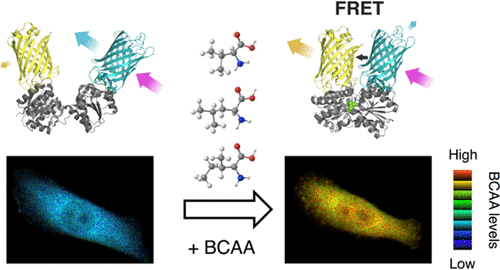Our official English website, www.x-mol.net, welcomes your
feedback! (Note: you will need to create a separate account there.)
OLIVe: A Genetically Encoded Fluorescent Biosensor for Quantitative Imaging of Branched-Chain Amino Acid Levels inside Single Living Cells.
ACS Sensors ( IF 8.2 ) Pub Date : 2019-12-17 , DOI: 10.1021/acssensors.9b02067 Tomoki Yoshida 1 , Hitomi Nakajima 1 , Sena Takahashi 1 , Akira Kakizuka 1 , Hiromi Imamura 1
ACS Sensors ( IF 8.2 ) Pub Date : 2019-12-17 , DOI: 10.1021/acssensors.9b02067 Tomoki Yoshida 1 , Hitomi Nakajima 1 , Sena Takahashi 1 , Akira Kakizuka 1 , Hiromi Imamura 1
Affiliation

|
Branched-chain amino acids (BCAAs) are essential amino acids, controlling cellular metabolic processes as signaling molecules; therefore, utilization of intracellular BCAAs may be regulated by the availability of nutrients in the environment. However, spatial and temporal regulation of intracellular BCAA concentration in response to environmental conditions has been unclear due to the lack of suitable methods for measuring BCAA concentrations inside single living cells. Here, we developed a Förster resonance energy transfer (FRET)-based genetically encoded biosensor for BCAAs, termed optical biosensor for leucine-isoleucine-valine (OLIVe). The biosensor showed approximately 2-fold changes in FRET values corresponding to BCAA concentrations. Importantly, FRET signals from HeLa cells expressing OLIVe in the cytoplasm and nucleus correlated with bulk intracellular BCAA concentrations determined from populations of cells by a biochemical method, and were decreased by knockdown of L-type amino acid transporter 1 (LAT1), a transporter for BCAAs, indicating that OLIVe can reliably report intracellular BCAA concentrations inside single living cells. We also succeeded in imaging BCAA concentrations in the mitochondria using mitochondria-targeted OLIVe. Using the BCAA imaging technique, we found apparently correlated concentrations between the cytoplasm and the mitochondria. We also found that extracellular non-BCAA amino acids affected intracellular BCAA concentrations. Of these amino acids, extracellular glutamine markedly increased intracellular BCAA concentrations in a LAT1-dependent manner. Unexpectedly, extracellular pyruvate was also found to have significant positive effects on maintaining intracellular BCAA concentrations, suggesting that the cells have pyruvate-dependent systems to import BCAAs and/or to regulate BCAA metabolism.
中文翻译:

OLIVe:用于单个活细胞内分支链氨基酸水平定量成像的遗传编码荧光生物传感器。
支链氨基酸(BCAA)是必需氨基酸,作为信号分子控制细胞的代谢过程。因此,细胞内BCAA的利用可能受到环境中营养物质的可用性的调节。然而,由于缺乏用于测量单个活细胞内部的BCAA浓度的合适方法,响应环境条件的细胞内BCAA浓度的时空调节尚不清楚。在这里,我们开发了基于Förster共振能量转移(FRET)的BCAA遗传编码生物传感器,称为亮氨酸-异亮氨酸-缬氨酸(OLIVe)的光学生物传感器。该生物传感器显示出对应于BCAA浓度的FRET值发生了大约2倍的变化。重要的,来自细胞质和细胞核中表达OLIVe的HeLa细胞的FRET信号与通过生化方法从细胞群体确定的大量细胞内BCAA浓度相关,并通过敲低BCAA转运蛋白L型氨基酸转运蛋白1(LAT1)而降低,表明OLIVe可以可靠地报告单个活细胞内的细胞内BCAA浓度。我们还成功地使用针对线粒体的OLIVe对线粒体中的BCAA浓度进行了成像。使用BCAA成像技术,我们发现细胞质和线粒体之间的浓度明显相关。我们还发现,细胞外的非BCAA氨基酸会影响细胞内的BCAA浓度。在这些氨基酸中,细胞外谷氨酰胺以LAT1依赖性方式显着增加细胞内BCAA浓度。
更新日期:2019-12-18
中文翻译:

OLIVe:用于单个活细胞内分支链氨基酸水平定量成像的遗传编码荧光生物传感器。
支链氨基酸(BCAA)是必需氨基酸,作为信号分子控制细胞的代谢过程。因此,细胞内BCAA的利用可能受到环境中营养物质的可用性的调节。然而,由于缺乏用于测量单个活细胞内部的BCAA浓度的合适方法,响应环境条件的细胞内BCAA浓度的时空调节尚不清楚。在这里,我们开发了基于Förster共振能量转移(FRET)的BCAA遗传编码生物传感器,称为亮氨酸-异亮氨酸-缬氨酸(OLIVe)的光学生物传感器。该生物传感器显示出对应于BCAA浓度的FRET值发生了大约2倍的变化。重要的,来自细胞质和细胞核中表达OLIVe的HeLa细胞的FRET信号与通过生化方法从细胞群体确定的大量细胞内BCAA浓度相关,并通过敲低BCAA转运蛋白L型氨基酸转运蛋白1(LAT1)而降低,表明OLIVe可以可靠地报告单个活细胞内的细胞内BCAA浓度。我们还成功地使用针对线粒体的OLIVe对线粒体中的BCAA浓度进行了成像。使用BCAA成像技术,我们发现细胞质和线粒体之间的浓度明显相关。我们还发现,细胞外的非BCAA氨基酸会影响细胞内的BCAA浓度。在这些氨基酸中,细胞外谷氨酰胺以LAT1依赖性方式显着增加细胞内BCAA浓度。











































 京公网安备 11010802027423号
京公网安备 11010802027423号